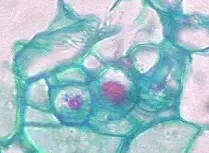Before entering fully into the meaning of the term phloem, it is necessary to proceed to discover its etymological origin. In this case, it must be stated that it derives from Greek, specifically from the word “phloios”, which can be translated as “bark”.
This word in question was given shape by a famous Swiss botanist named Karl Wilhem von Nageli (1817 – 1891). Specifically, he created it in 1873.
The concept of phloem refers to the tissue present in certain plants whose function is to conduct certain substances through these organisms. This conduction tissue allows the transfer of nutrients produced by the autotrophic and photosynthetic sector of vascular plants (the aerial part) to the heterotrophic and non-photosynthetic sectors (the underground part).
 It is possible to differentiate between primary phloem and secondary phloem . The primary phloem has its origin in the procambium, which is part of the meristem or meristem (the embryonic tissue that has the ability to resort to continuous divisions to give rise to other specialized tissues). In turn, it is divided into protophloem (which matures while the plant is still growing ) and metaphloem (which completes its maturation when the plant has already completed its growth in length).
It is possible to differentiate between primary phloem and secondary phloem . The primary phloem has its origin in the procambium, which is part of the meristem or meristem (the embryonic tissue that has the ability to resort to continuous divisions to give rise to other specialized tissues). In turn, it is divided into protophloem (which matures while the plant is still growing ) and metaphloem (which completes its maturation when the plant has already completed its growth in length).
The secondary phloem, for its part, arises in the cambium, which is another type of meristematic tissue. This phloem has a radial system and an axial system.
At a general level, phloem is made up of various types of cells . Specifically, we can establish that the phloem is made up of four different types of cells. We are referring to the following:
-The sclerenchymatic cells or elements, which act as support and can be of two kinds: the fibers, which are longer in the primary phloem and shorter in the secondary phloem, and the sclereids, which have the peculiarity that they can occur alone or with fibers.
-The cells or sieve elements, which are responsible for conducting organic nutrients over a long distance. Of this type are the members of the sieve tubes and the sieve cells.
-The glandular elements and idioblasts, whose functions are to act as a deposit and also undertake secretion.
-The parenchymatic elements. We have to establish these phloem cells that are responsible for storage and also for moving forward, which is the loading and unloading of the sieve tubes. In this group are albuminous cells, companion cells, radial parenchyma cells and axial parenchyma cells.
It is important to distinguish between phloem and xylem . Both are vascular tissues, although they have different structures and functions. Together they make up the so-called vascular bundles: in the internal part of the bundles is the xylem, while in the external sector the phloem appears.
While phloem carries processed sap ( water with sugars, minerals, amino acids and more organic substances), xylem carries raw sap (water and salts that come from the root).
